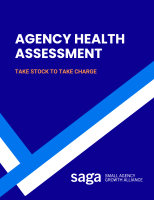Most agency leaders want to exceed expectations for their clients – and that should definitely be the goal.
But how do you achieve that without falling into the trap of over-servicing your client and running into profitability problems for your business?
It starts with understanding that there is an important distinction between over-delivering and over-servicing.
It starts with recognizing that over-delivery is about the results that you provide, while over-servicing is about the amount of work that you and your team perform.
While over-servicing might produce more results, there is no guarantee that it will – nor is extra work even required to deliver results beyond the client’s expectations.
How to over-deliver for your clients
If over-delivery isn’t about putting in more hours, how do you do it?
It starts with setting reasonable expectations with your clients before they even sign on the dotted line. Too often we allow clients to think we can work magic because we really want to win their business.
It is better to temper those expectations at the start – not by low-balling them, but by tapping into your own expertise and experience to let them know what is realistic.
One of the reasons that finding a focus for your agency and clearly defining your ideal client is so important is because it allows you to develop that expertise and experience so that you can become more efficient at delivering results.
That efficiency gives you room to over-deliver without burning up needless staff time to achieve that goal.
Another key to successful over-delivery is to plan – and price – properly.
If you’re going to invest extra effort to produce more results, then you need to factor that into your client project budgets and account for the increased staff costs in the rates that you charge.
If you can get really good at estimating and pricing, then you have much more room to maneuver when it comes to exceeding your client’s expectations and helping them to continue to love working with you and your team.
How to avoid over-servicing
If over-delivery is good and over-servicing is bad, how do you keep from running into the danger of spending more and more while making less and less?
It starts with a focus on expectations, scope, and pricing, as noted above, but that’s just setting the table for success.
Providing excellent results at a reasonable cost only succeeds when that upfront planning meets effective day-to-day management.
The managers of the client relationship need to know what has been promised – both in terms of results as well as inputs. You need to give them visibility to the project work estimates and the client scope of work document so that they are able to make informed decisions.
Next, you need to empower your account managers to keep their work focused on what has been agreed and come to you for any out-of-scope requests.
At the same time, not all over-servicing results from scope creep or accommodating client requests. Sometimes it is because you didn’t use accurate estimates in the first place.
We all make mistakes with our work estimates, and that’s fine as long as we continue to review them and learn from those missed targets.
That’s where time tracking comes in. It is bad enough to over-service a client, but when you do it without knowing that’s where it can become a major burden on your agency’s profitability. (And when profitability takes a hit, most agencies pressure team members to work more hours to make up for the shortfall.)
Make sure that your team feels comfortable with reporting the accurate amount of time that it takes to do things and coming to you with concerns as soon as possible when they see something that is veering beyond the budgeted hours.
Conclusion
The most successful agencies find a way to over-deliver for their clients while managing to do so efficiently without over-servicing.
Focusing on the results that you provide and understanding that it is different from the amount of work that you do will help position your business to meet this goal.
Frontline client management coupled with accurate reporting (and adapting to the information gleaned) will help you to repeat and even improve upon these metrics over time.










